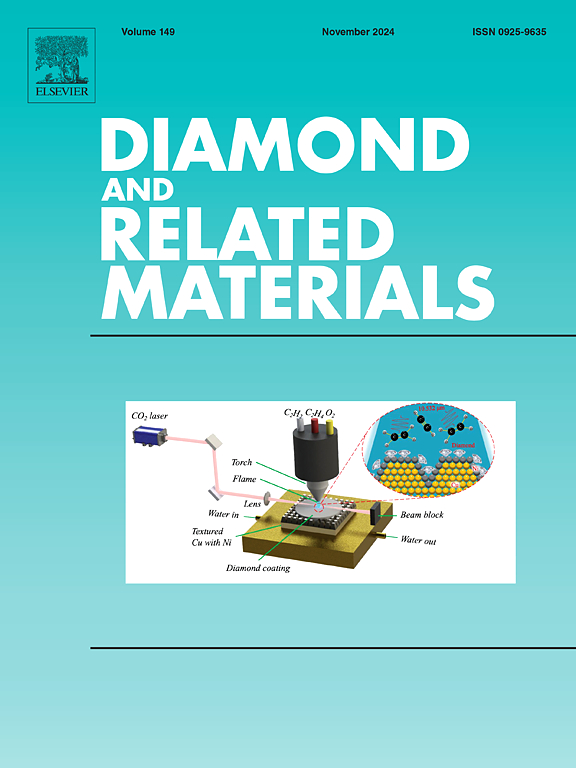激光散射检测化学气相沉积金刚石H2/CH4/Ar等离子体中固体颗粒及其对晶体生长的影响
IF 4.3
3区 材料科学
Q2 MATERIALS SCIENCE, COATINGS & FILMS
引用次数: 0
摘要
金刚石的特殊性能使其成为各种应用的理想选择。化学气相沉积(CVD)技术是制备用于器件的金刚石薄膜的重要技术。在CVD过程中,气相中固体颗粒的形成是该目的的一个重要焦点,因为避免了可能导致降解的颗粒夹杂,为实现晶体质量和器件性能的显着改善提供了机会。该研究首次展示了在金刚石CVD环境中使用激光散射对固体颗粒的原位定量检测,并评估了固体颗粒与CVD生长薄膜晶体质量之间的相关性。在含有大量Ar组分(28 - 47%)的H2/CH4/Ar等离子体中,在120 Torr左右的压力下,在气相中检测到固体颗粒。在检测到大量固体颗粒的条件下,外延生长的金刚石薄膜表现出嵌入的非外延晶体和退化的晶体质量。这些发现为优化高质量金刚石薄膜的CVD工艺提供了新的见解,并有助于提高未来金刚石器件应用的可靠性。本文章由计算机程序翻译,如有差异,请以英文原文为准。

Detection of solid particles in H2/CH4/Ar plasma for chemical vapor deposition of diamond by laser light scattering and their effect on crystal growth
Diamond's exceptional properties make it ideal for various applications. Chemical vapor deposition (CVD) is an essential technique for fabricating diamond films used in device applications. The formation of solid particles in the gas phase during CVD is a significant focus of this purpose, as avoiding particle inclusion, which can lead to degradation, presents an opportunity to achieve remarkable improvements in crystal quality and device performance. This study is the first to demonstrate in-situ quantitative detection of solid particles in a diamond CVD environment using laser light scattering as well as evaluation of the correlation between solid particles and the crystal quality of CVD-grown films. In an H2/CH4/Ar plasma with substantial Ar fractions (28–47 %), solid particles were detected in the gas phase at pressures around 120 Torr. Diamond films grown epitaxially under conditions with a high number of detected solid particles exhibited embedded unepitaxial crystals and degraded crystal quality. These findings offer new insights into optimizing CVD processes for high-quality diamond films and contribute to improved reliability for future diamond device applications.
求助全文
通过发布文献求助,成功后即可免费获取论文全文。
去求助
来源期刊

Diamond and Related Materials
工程技术-材料科学:综合
CiteScore
6.00
自引率
14.60%
发文量
702
审稿时长
2.1 months
期刊介绍:
DRM is a leading international journal that publishes new fundamental and applied research on all forms of diamond, the integration of diamond with other advanced materials and development of technologies exploiting diamond. The synthesis, characterization and processing of single crystal diamond, polycrystalline films, nanodiamond powders and heterostructures with other advanced materials are encouraged topics for technical and review articles. In addition to diamond, the journal publishes manuscripts on the synthesis, characterization and application of other related materials including diamond-like carbons, carbon nanotubes, graphene, and boron and carbon nitrides. Articles are sought on the chemical functionalization of diamond and related materials as well as their use in electrochemistry, energy storage and conversion, chemical and biological sensing, imaging, thermal management, photonic and quantum applications, electron emission and electronic devices.
The International Conference on Diamond and Carbon Materials has evolved into the largest and most well attended forum in the field of diamond, providing a forum to showcase the latest results in the science and technology of diamond and other carbon materials such as carbon nanotubes, graphene, and diamond-like carbon. Run annually in association with Diamond and Related Materials the conference provides junior and established researchers the opportunity to exchange the latest results ranging from fundamental physical and chemical concepts to applied research focusing on the next generation carbon-based devices.
 求助内容:
求助内容: 应助结果提醒方式:
应助结果提醒方式:


